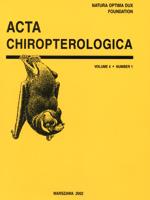We examined the influence of average climatic conditions and nightly weather variations using bat detectors on the summer activity of bats. Average summer precipitation was the principal climate variable correlated with differences in bat activity along a latitudinal array of sites, with the highest activity levels occurring at sites located in montane rain shadows. On a nightly basis, the occurrence of rain and low temperatures had strong negative correlations with flight activity. However, the variation in nightly activity at a site that was explained by weather was relatively small. Our results suggest that the use of long-term climatic data offers potential to predict variations in bat activity among sites. Such information may be useful in recognizing conservation priorities for the management of bats in the Pacific Northwest where topography is complex and climate conditions are variable.
How to translate text using browser tools
1 June 2002
The Influence of Regional Climate and Nightly Weather Conditions on Activity Patterns of Insectivorous Bats
Janet L. Erickson,
Stephen D. West
R. E. Christy
, and
S. D. West
.
1993. Biology of bats in Douglas-fir forests. U.S. Forest Service General Technical Report PNW-GTR-308, 28 pp. Google Scholar
C. Daly
,
R. P. Neilson
, and
D. L. Phillips
.
1994. A statistical-topographic model for mapping climatological precipitation over mountainous terrain. Journal of Applied Meteorology, 33: 140–158. Google Scholar
J. L. Erickson
1998. The influence of regional, landscape, and local habitat conditions on bat activity in forests of the Pacific Northwest. Ph.D. Dissertation, University of Washington, Seattle, 151 pp. Google Scholar
H. G. Erkert
1982. Ecological aspects of bat activity rhythms. Pp. 201–242,
in
Ecology of bats (
T. H. Kunz
, ed.).
Plenum Press, New York, 425 pp. Google Scholar
M. B. Fenton
, and
D. Morris
.
1976. Opportunistic feeding by desert bats (Myotis spp.). Canadian Journal of Zoology, 54: 526–530. Google Scholar
J. S. Findley
1993. Bats: a community perspective. Cambridge University Press, New York, 167 pp. Google Scholar
J. F. Franklin
, and
C. T. Dyrness
.
1973. Natural vegetation of Oregon and Washington. Oregon State University Press, Corvallis, 452 pp. Google Scholar
S. D. GrindaL
,
T. S. Collard
,
R. M. Brigham
, and
R. M. R. Barclay
.
1992. The influence of precipitation on reproduction by Myotis bats in British Columbia. American Midland Naturalist, 128: 339–344. Google Scholar
K. R. Hecker
, and
R. M. Brigham
.
1999. Does moonlight change vertical stratification of activity by forest-dwelling insectivorous bats? Journal of Mammalogy, 80: 1196–1201. Google Scholar
S. E. Lewis
1993. Effect of climatic variation on reproduction by pallid bats (Antrozous pallidus). Canadian Journal of Zoology, 71: 1429–1433. Google Scholar
C. Maier
1992. Activity patterns of pipistrelle bats (Pipistrellus pipistrellus) in Oxfordshire. Journal of Zoology (London), 228: 69–80. Google Scholar
P. A. Racey
, and
J. R. Speakman
.
1987. The energy costs of pregnancy and lactation in heterothermic bats. Symposia of the Zoological Society of London, 57: 107–125. Google Scholar
P. A. Racey
, and
S. M. Swift
.
1981. Variations in gestation length in a colony of pipistrelle bats (Pipistrellus pipistrellus) from year to year. Journal of Reproduction and Fertility, 61: 123–129. Google Scholar
C. C. Reith
1982. Insectivorous bats fly in shadows to avoid moonlight. Journal of Mammalogy, 63: 685–688. Google Scholar
D. W. Thomas
, and
S. D. West
.
1991. Forest age associations of bats in the southern Washington Cascade and Oregon Coast Ranges. Pp. 295–303,
in
Wildlife and vegetation of unmanaged Douglas-fir forests (
F. Ruggiero L.
,
K. B. Aubry
,
A. B. Carey
, and
M. H. Huff
, eds.).
U.S. Forest Service General Technical Report PNW GTR-285, 533 pp. Google Scholar

Acta Chiropterologica
Vol. 4 • No. 1
June 2002
Vol. 4 • No. 1
June 2002
activity patterns
bat detector
bats
Climate
Pacific Northwest




